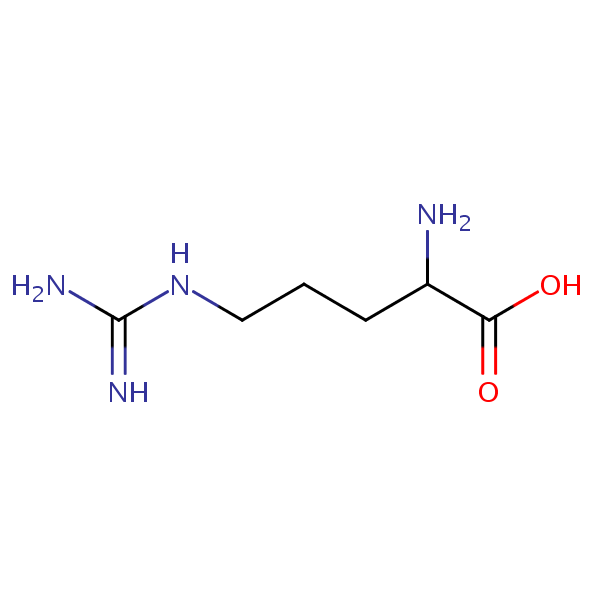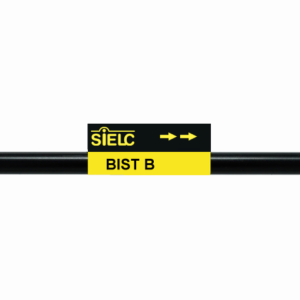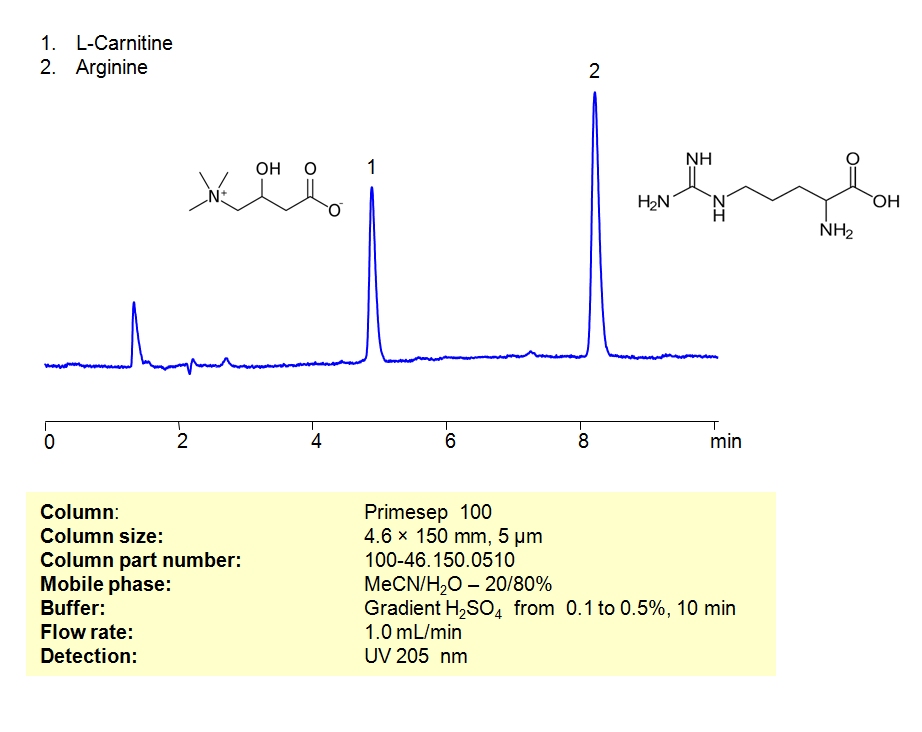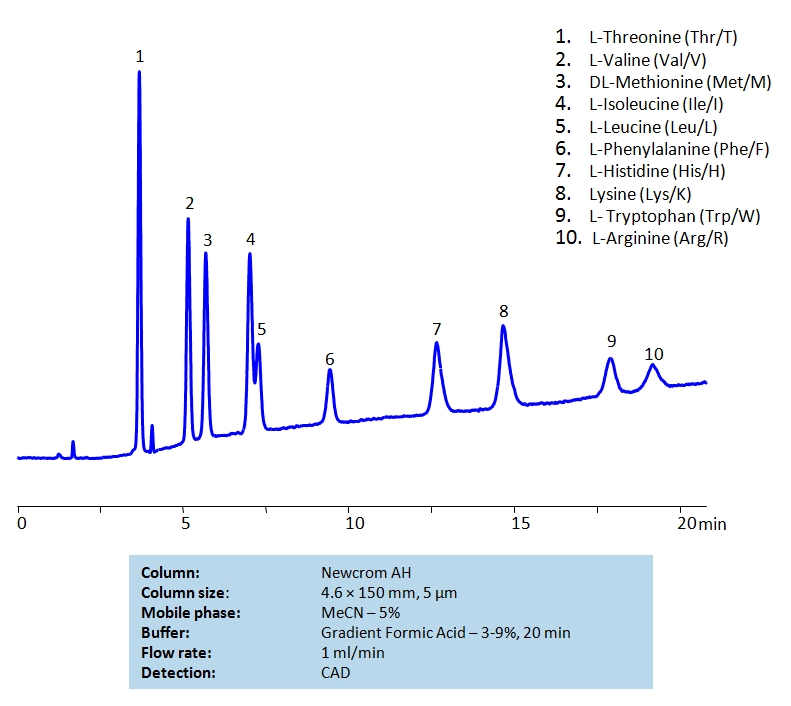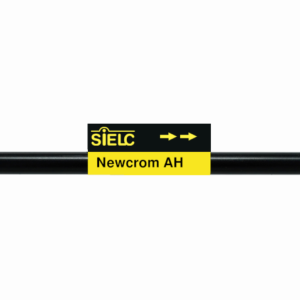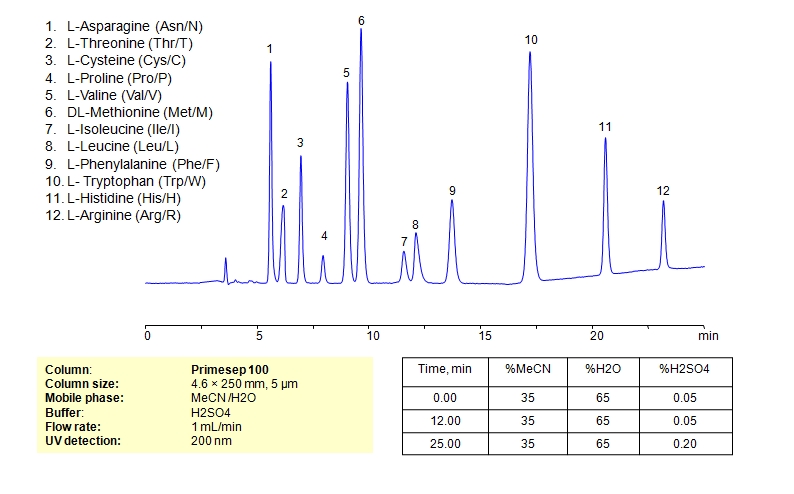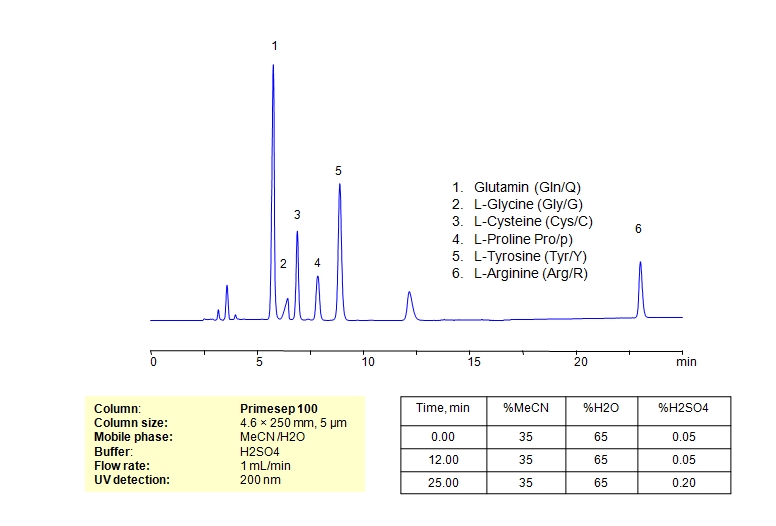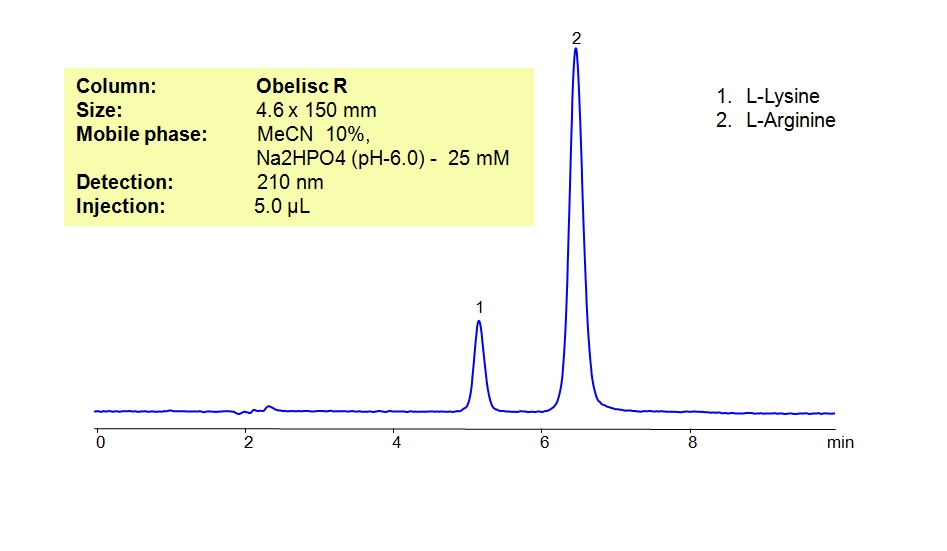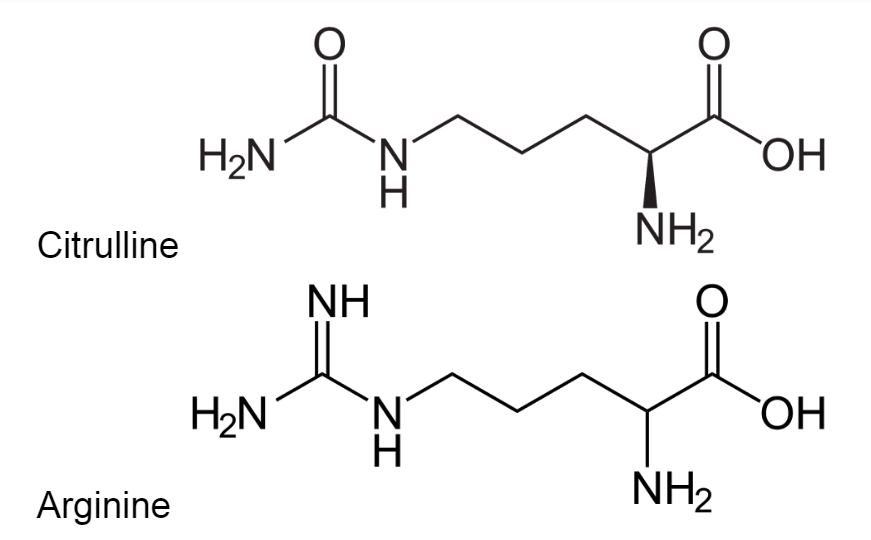| CAS Number | 7200-25-1 |
|---|---|
| Molecular Formula | C6H14N4O2 |
| Molecular Weight | 174.204 |
| InChI Key | ODKSFYDXXFIFQN-UHFFFAOYSA-N |
| LogP | -3.05 |
| Synonyms |
|
Applications:
HPLC Method for Separation of Arginine and Ciraparantag on BIST B Column Column
March 15, 2024
HPLC Method for Analysis of Ciraparantag, Arginine on BIST B Column by SIELC Technologies
Separation type: Liquid Chromatography Reversed-phase

Ciraparantag, also known as andexanet alfa, is a recombinant modified human factor Xa (FXa) protein. It is designed to reverse the anticoagulant effects of direct and indirect factor Xa inhibitors, such as rivaroxaban, apixaban, edoxaban, and enoxaparin.
Ciraparantag works by binding to the factor Xa inhibitors in the bloodstream, thereby neutralizing their anticoagulant activity. This reversal agent can be particularly useful in emergency situations where rapid reversal of anticoagulation is necessary, such as in cases of severe bleeding or when urgent surgery is required.
Ciraparantag has been approved for use in some regions, including the United States, for the treatment of life-threatening or uncontrolled bleeding associated with factor Xa inhibitor therapy. It is typically administered intravenously under the supervision of healthcare professionals.
It’s important to note that ciraparantag is not effective against anticoagulants that do not target factor Xa, such as warfarin. Additionally, like any medication, ciraparantag may have potential side effects, and its use should be carefully monitored by healthcare providers.
Ciraparantag can be retained and analyzed on a Primesep N mixed-mode stationary phase column using an analytical method with a simple mobile phase of water, Acetonitrile (MeCN) , and a sulfonic acid as a buffer. This analysis method can be detected using LC MS.
High Performance Liquid Chromatography (HPLC) Method for Analyses of Ciraparantag, Arginine on BIST B Column by SIELC Technologies
Condition
| Column | BIST B, 4.6 x 150 mm, 5 µm, 100 A |
| Mobile Phase | Gradient MeCN – 85-30% |
| Buffer | H2SO4 – 0.2% |
| Flow Rate | 1.0 ml/min |
| Detection | UV 200 nm |
Description
| Class of Compounds | Bis-biguanide |
| Analyzing Compounds | Ciraparantag, Arginine |
Application Column
Ciraparantag

HPLC Method for Analysis of Arginine, Lysine and Histidine Amino Acids on BIST B+
November 30, 2022
HPLC Method for Analysis of Arginine, Lysine and Histidine Amino Acids on BIST B+ by SIELC Technologies.
Separation type: Bridge Ion Separation Technology, or BIST™ by SIELC Technologies
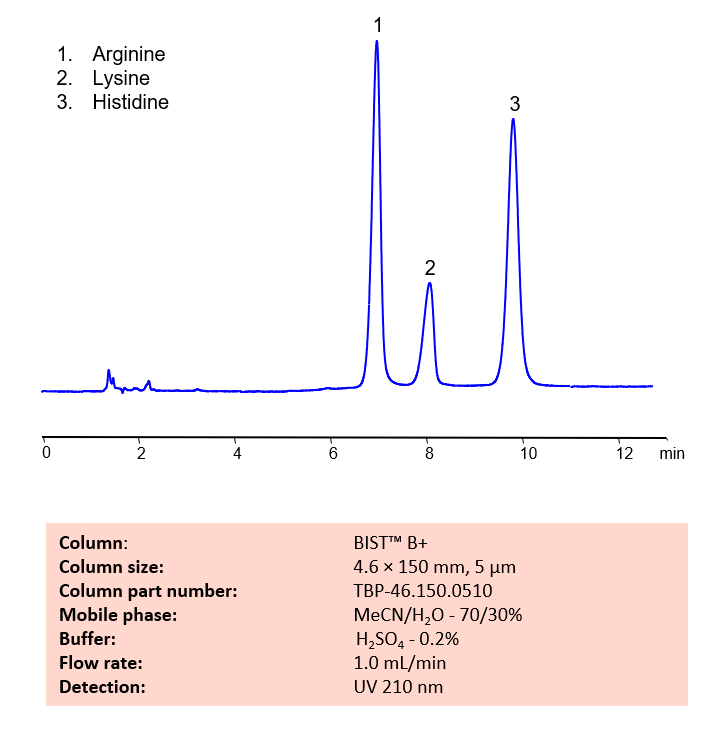
High Performance Liquid Chromatography (HPLC) Method for Analyses of Arginine, Lysine and Histidine Amino Acids
Basic amino acids, like Arginine, Lysine, and Histidine, can be difficult to separate and retain in typical reverse-phase chromatography. Arginine is a naturally-occurring, essential amino acid typically found in meat, poultry, and fish. Lysine is another essential amino acid typically found in meat, and also cereal grains. A third essential amino acid, Histidine, is also typtically found in meat, poultry, and also cereal grains (like rice, wheat, and rye). Using SIELC’s newly introduced BIST™ method, these three essential amino acids, which protonate in water, can be retained on a positively-charged anion-exchange BIST™ B column. There are two keys to this retention method: 1) a multi-charged, negative buffer, such as Sulfuric acid (H2SO4), which acts as a bridge, linking the positively-charged amino acid analytes to the positively-charged column surface and 2) a mobile phase consisting mostly of organic solvent (such as MeCN) to minimize the formation of a solvation layer around the charged analytes. Using this new and unique analysis method, Arginine, Lysine, and Histidine can be retained and UV detected at 210 nm.
Condition
| Column | BIST B+, 4.6×150 mm, 5 µm, 100A |
| Mobile Phase | MeCN – 70% |
| Buffer | H2SO4 – 0.2% |
| Flow Rate | 1.0 ml/min |
| Detection | UV 210 nm |
| Peak Retention Time | 6.2, 8.0, 9.9 min |
Description
| Class of Compounds | Amino acid |
| Analyzing Compounds | Arginine, Lysine, Histidine |
Application Column
BIST B
BIST™ columns offer a unique and effective way to achieve separations that were traditionally challenging or even impossible with other HPLC columns. With the use of a special mobile phase, these ion exchange columns provide very strong retention for analytes with the same charge polarity as the stationary phase, unlocking new chromatography applications. What makes BIST™ columns stand out is their proprietary surface chemistry, which results in superior selectivity, resolution, and sensitivity. These columns offer a simple, efficient solution for a variety of analytical challenges, making them an excellent choice for researchers and analysts across many different fields. To learn more about the technology that powers BIST™ columns and to explore related applications, check out https://BIST.LC.
Select optionsBIST B+
BIST™ columns offer a unique and effective way to achieve separations that were traditionally challenging or even impossible with other HPLC columns. With the use of a special mobile phase, these ion exchange columns provide very strong retention for analytes with the same charge polarity as the stationary phase, unlocking new chromatography applications. What makes BIST™ columns stand out is their proprietary surface chemistry, which results in superior selectivity, resolution, and sensitivity. These columns offer a simple, efficient solution for a variety of analytical challenges, making them an excellent choice for researchers and analysts across many different fields. To learn more about the technology that powers BIST™ columns and to explore related applications, check out https://BIST.LC.
Select optionsHistidine
Lysine

HPLC Method For Analysis Of L-Carnitine and Arginine on Primesep 100 Column
February 3, 2022
Separation type: Liquid Chromatography Mixed-mode
High Performance Liquid Chromatography (HPLC) Method for Analysis of L-Carnitine and Arginine
L-carnitine is a quaternary ammonium cation (also known as a quat) that is key to the metabolic processes of most living species. Arginine is an alpha amino acid that is key to the biosynthesis of proteins.
These two amine-based compounds can be detected in the low UV regime. Using a Primesep 100 mixed-mode column and a gradient mobile phase consisting of water and acetonitrile (MeCN) with a gradient of sulfuric acid (H2SO4) as a buffer, L-carnitine and Arginine can be retained, separated, and analyzed. This analysis method can be UV detected at 205 nm.
| Column | Primesep 100, 4.6×150 mm, 5 µm, 100A |
| Mobile Phase | MeCN/H2O – 20/80% |
| Buffer | Gradient H2SO4 from 0.1 to 0.5%, 10 min |
| Flow Rate | 1.0 ml/min |
| Detection | UV, 205 nm |
| Class of Compounds |
Amino acid |
| Analyzing Compounds | Carnitine, Arginine |
Application Column
Primesep 100
The Primesep family of mixed-mode columns offers a wide variety of stationary phases, boasting unprecedented selectivity in the separation of a broad array of chemical compounds across multiple applications. Corresponding Primesep guard columns, available with all stationary phases, do not require holders. SIELC provides a method development service available to all customers. Inquire about our specially-tailored custom LC-phases for specific separations.
Select optionsCarnitine

HPLC Separation of Mixture of Nine Essential Amino acids and Arginine on Newcrom AH Column
September 25, 2020
Essential amino acids cannot be made by the body. As a result, they must come from food.
The 9 essential amino acids are: histidine, isoleucine, leucine, lysine, methionine, phenylalanine, threonine, tryptophan, and valine.
| Column | Newcrom AH, 4.6×150 mm, 5 µm, 100A |
| Mobile Phase | MeCN – 5% |
| Buffer | Gradient Formic Acid – 3-9%, 20 min |
| Flow Rate | 1.0 ml/min |
| Detection | CAD |
| Class of Compounds |
Drug, Acid, Hydrophilic, Ionizable, Vitamin, Supplements, Amino acid |
| Analyzing Compounds | L-Threonine (Thr/T), L-Valine (Val/V), DL-Methionine (Met/M), L-Isoleucine (Ile/I), L-Leucine (Leu/L), L-Phenylalanine (Phe/F), L-Histidine (His/H), Lysine (Lys/K) , L- Tryptophan (Trp/W), L-Arginine (Arg/R) |
Application Column
Newcrom AH
The Newcrom columns are a family of reverse-phase-based columns. Newcrom A, AH, B, and BH are all mixed-mode columns with either positive or negative ion-pairing groups attached to either short (25 Å) or long (100 Å) ligand chains. Newcrom R1 is a special reverse-phase column with low silanol activity.
Select optionsHistidine
Isoleucine
L-Threonine
Leucine
Lysine
Methionine
Phenylalanine
Tryptophan
Valine

HPLC Separation of Mixture of 12 Amino Acids on Primesep 100 Column
March 11, 2019
| Column | Primesep 100, 4.6×250 mm, 5 µm, 100A |
| Mobile Phase | MeCN/H2O – 35/65% |
| Buffer | H2SO4 0.05% 12 min hold, gradient 0.05-0.20, 13 min |
| Flow Rate | 1.0 ml/min |
| Detection | UV, 200 nm |
| Class of Compounds |
Drug, Acid, Hydrophilic, Ionizable, Vitamin, Supplements, Amino acid |
| Analyzing Compounds | L-Asparagine (Asn/N), L-Threonine (Thr/T), L-Cysteine (Cys/C), L-Proline (Pro/P), L-Valine (Val/V), DL-Methionine (Met/M), L-Isoleucine (Ile/I), L-Leucine (Leu/L), L-Phenylalanine (Phe/F), L- Tryptophan (Trp/W), L-Histidine (His/H), L-Arginine (Arg/R) |
Application Column
Primesep 100
The Primesep family of mixed-mode columns offers a wide variety of stationary phases, boasting unprecedented selectivity in the separation of a broad array of chemical compounds across multiple applications. Corresponding Primesep guard columns, available with all stationary phases, do not require holders. SIELC provides a method development service available to all customers. Inquire about our specially-tailored custom LC-phases for specific separations.
Select optionsArginine
Asparagine
Cysteine
D-Isoleucine
D-Leucine
D-Valine
DL-Isoleucine
Histidine
Isoleucine
L-Cysteine
L-Methionine
L-Threonine
Leucine
Methionine
Phenylalanine
Proline
Tryptophan
Valine

HPLC Separation of Mixture of Conditionally Essential Amino Acids on Primesep 100 Column
March 11, 2019
| Column | Primesep 100, 4.6×250 mm, 5 µm, 100A |
| Mobile Phase | MeCN/H2O – 35/65% |
| Buffer | H2SO4 0.05% 12 min hold, gradient 0.05-0.20, 13 min |
| Flow Rate | 1.0 ml/min |
| Detection | UV, 200 nm |
| Class of Compounds |
Drug, Acid, Hydrophilic, Ionizable, Vitamin, Supplements, Amino acid |
| Analyzing Compounds | Glutamin (Gln/Q), L-Glycine (Gly/G), L-Cysteine (Cys/C), L-Proline Pro/p), L-Tyrosine (Tyr/Y), L-Arginine (Arg/R) |
Application Column
Primesep 100
The Primesep family of mixed-mode columns offers a wide variety of stationary phases, boasting unprecedented selectivity in the separation of a broad array of chemical compounds across multiple applications. Corresponding Primesep guard columns, available with all stationary phases, do not require holders. SIELC provides a method development service available to all customers. Inquire about our specially-tailored custom LC-phases for specific separations.
Select optionsArginine
Cysteine
Glycine
L-Cysteine
L-Glutamine
Proline
Tyrosine

HPLC Method for Analysis of L-Lysine and L-Arginine
February 28, 2018
L-Lysine is an essential amino acid required for growth and tissue repair, it can also help with anxiety. The amino acid is most often found in red meats,beans, fish, and dairy products. L-Arginine is an essential amino acid that is used to treat congestive heart failure, combat fatigue and circulatory diseases. It is also used to stimulate the immune system. Obelisc R is a reverse-phase column. It contains embedded ionic groups and can retain L-Lysine and L-Arginine. The method is UV compatible and can be used as a general approach for analyzing similar compounds.
| Column | Obelisc R, 4.6×150 mm, 5 µm, 100A |
| Mobile Phase | MeCN/H2O – 10/90% |
| Buffer | Na2HPO4 pH 6.0 – 25 mM |
| Flow Rate | 1.0 ml/min |
| Detection | UV, 210 nm |
| Class of Compounds |
Drug, Acid, Hydrophilic, Ionizable, Vitamin, Supplements, Amino acid |
| Analyzing Compounds | Arginine, L-Lysine |
Application Column
Obelisc R
SIELC has developed the Obelisc™ columns, which are mixed-mode and utilize Liquid Separation Cell technology (LiSC™). These cost-effective columns are the first of their kind to be commercially available and can replace multiple HPLC columns, including reversed-phase (RP), AQ-type reversed-phase, polar-embedded group RP columns, normal-phase, cation-exchange, anion-exchange, ion-exclusion, and HILIC (Hydrophilic Interaction Liquid Chromatography) columns. By controlling just three orthogonal method parameters - buffer concentration, buffer pH, and organic modifier concentration - users can adjust the column properties with pinpoint precision to separate complex mixtures.
Select optionsD-Lysine
Lysine
N-Nitro-L-arginine

HPLC Separation of Lysine and Arginine from Other Amino Acids
July 10, 2012
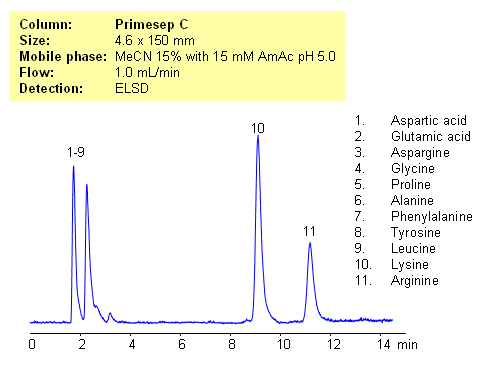
Application Notes: Amino acids are polar ionic compounds which are not retained on reversed-phase column without ion-pairing reagent. In our application, lysine and arginine can be separated from other amino acids. Amino acids with a pH between 3 and 5 and with one basic and one acidic group become very polar. Therefore these amino acids don’t have strong ion-exchange interaction with Primesep C stationary phase. Amino acids with two amino groups still carry positive net charge and can interact with stationary phase by cations-exchange mechanism. pH variation of the mobile phase can be an effective tool to adjust selectivity of separation for zwitter-ionic, basic and acidic compounds. This method can be used for separation of mono-charged compounds from compounds having an extra charge.
Application Columns: Primesep C
Application compounds: Aspartic acid, Glutamic acid, Aspargine, Glycine, Proline, Alanine, Phenylalanine, Tyrosine, Leucine, Lysine, Arginine
Detection technique: UV, LC/MS, ELSD/CAD
| Column | Primesep C, 4.6×150 mm, 5 µm, 100A |
| Mobile Phase | MeCN – 15% |
| Buffer | AmAc pH 5.0- 15 mM |
| Flow Rate | 1.0 ml/min |
| Detection | ELSD |
| Class of Compounds |
Drug, Acid, Hydrophilic, Ionizable, Vitamin, Supplements |
| Analyzing Compounds | Aspartic acid, Glutamic acid, Aspargine, Glycine, Proline, Alanine, Phenylalanine, Tyrosine, Leucine, Lysine, Arginine |
Application Column
Primesep C
The Primesep family of mixed-mode columns offers a wide variety of stationary phases, boasting unprecedented selectivity in the separation of a broad array of chemical compounds across multiple applications. Corresponding Primesep guard columns, available with all stationary phases, do not require holders. SIELC provides a method development service available to all customers. Inquire about our specially-tailored custom LC-phases for specific separations.
Select optionsArginine
Asparagine
Aspartic Acid
Glutamic Acid
Glycine
Leucine
Lysine
Phenylalanine
Proline
Tyrosine
UV Detection

HPLC Analysis of Active Drug and Amino Acids in a Formulation
October 14, 2010
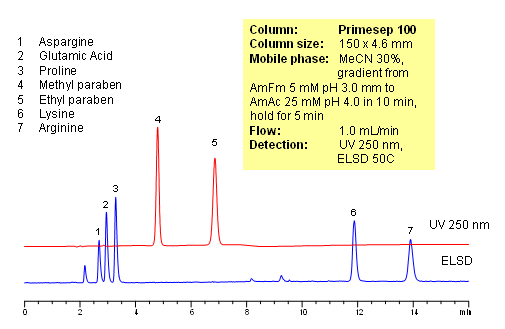
Polar amino acids are very often used as components of vitamin and supplement composition. Analysis of such complex composition is a challenging task. In this application, 5 amino acids (asparagine, glutamic acid, proline and arginine) and two preservatives (methyl paraben and propyl paraben) are separated on a Primesep 100 reversed-phase cation-exchange column with LC/MS compatible mobile phase. Method does not require ion-pairing reagent in the mobile phase. Compounds are monitored by ELSD and UV. Method is validated for quantitation of underivatized amino acids in complex mixtures. The method is simple and robust and can be used for analysis of various vitamin formulations.
| Column | Primesep 100, 4.6×150 mm, 5 µm, 100A |
| Mobile Phase | MeCN/H2O |
| Buffer | AmFm |
| Flow Rate | 1.0 ml/min |
| Detection | ELSD 50C, UV 250 nm |
| Class of Compounds |
Drug, Acid, Hydrophilic, Ionizable, Vitamin, Supplements |
| Analyzing Compounds | Glutamic acid, Aspargine, Proline, Lysine, Arginine, Methyl paraben, Propyl paraben |
Application Column
Primesep 100
The Primesep family of mixed-mode columns offers a wide variety of stationary phases, boasting unprecedented selectivity in the separation of a broad array of chemical compounds across multiple applications. Corresponding Primesep guard columns, available with all stationary phases, do not require holders. SIELC provides a method development service available to all customers. Inquire about our specially-tailored custom LC-phases for specific separations.
Select optionsAsparagine
Ethylparaben
Glutamic Acid
Lysine
Methylparaben
Proline
UV Detection

HPLC Analysis of Citrulline and Arginine on Primesep Columns
October 14, 2010
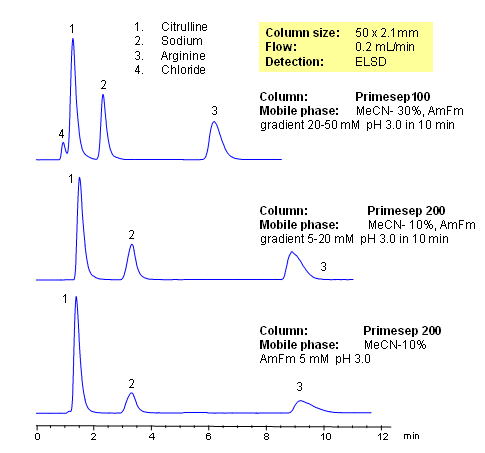
Two underivatized amino acids, citrulline and arginine, are separated by mixed-mode chromatography on Primesep 100 and Primesep 200 HPLC columns with LC/MS compatible mobile phase. Method can be used for retention and separation of underivatized amino acids without ion-pairing reagent in the mobile phase.
| Column | Primesep, 2.1×50 mm, 5 µm, 100A |
| Mobile Phase | MeCN/H2O |
| Buffer | AmFm pH 3.0 |
| Flow Rate | 0.2 ml/min |
| Detection | ELSD |
| Class of Compounds |
Ions, Hydrophilic, Ionizable |
| Analyzing Compounds | Sodium, Citrulline, Arginine, Chloride |
Application Column
Primesep 100
The Primesep family of mixed-mode columns offers a wide variety of stationary phases, boasting unprecedented selectivity in the separation of a broad array of chemical compounds across multiple applications. Corresponding Primesep guard columns, available with all stationary phases, do not require holders. SIELC provides a method development service available to all customers. Inquire about our specially-tailored custom LC-phases for specific separations.
Select optionsCitrulline

HPLC Separation of Citrulline and Arginine on Primesep 200 Column
November 21, 2006
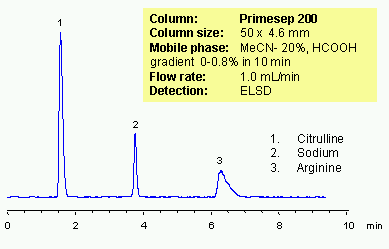
Citrulline and Arginine are α-amino acids that differ only in one functional group. They can be separated on a reverse-phase Primesep 200 HPLC column by hydrophobic and cation-exchange mechanisms in a mobile phase of water and acetonitrile (MeCN, ACN) with a gradient buffer of formic acid. Evaporative Light Scattering Detector (ELSD) used.
| Column | Primesep 200, 4.6×50 mm, 5 µm, 100A |
| Mobile Phase | MeCN/H2O |
| Buffer | Formic Acid |
| Flow Rate | 1.0 ml/min |
| Detection | ELSD |
| Class of Compounds |
Ions, Hydrophilic, Ionizable |
| Analyzing Compounds | Sodium, Citrulline, Arginine |
Application Column
Primesep 200
The Primesep family of mixed-mode columns offers a wide variety of stationary phases, boasting unprecedented selectivity in the separation of a broad array of chemical compounds across multiple applications. Corresponding Primesep guard columns, available with all stationary phases, do not require holders. SIELC provides a method development service available to all customers. Inquire about our specially-tailored custom LC-phases for specific separations.
Select optionsCitrulline
Sodium

Amino Acids Analysis in Acid Gradient Condition
September 18, 2006
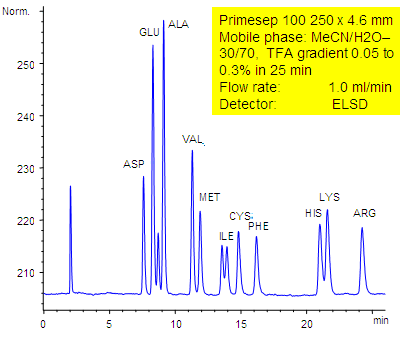
11 underivatized amino acids (aspartic acid, glutamic acid, alanine, valine, methionine, isoleucine, cysteine, phenylalanine, histidine, lysine, and arginine) are separated by a Primesep 100 HPLC column by reversed-phase and ion-exchange mechanisms with LC/MS compatible conditions without the use of ion-pair reagents. The HPLC separation uses a TFA (trifluoroacetic acid) gradient in a mobile phase of water acetonitrile (MeCN, ACN with evaporative light scattering detection (ELSD).
| Column | Primesep 100, 4.6×250 mm, 5 µm, 100A |
| Mobile Phase | MeCN/H2O – 30/70% |
| Buffer | TFA , gradient 0.05-0.3 % , 25 min |
| Flow Rate | 1.0 ml/min |
| Detection | ELSD |
| Class of Compounds |
Drug, Acid, Hydrophilic, Ionizable, Vitamin, Supplements |
| Analyzing Compounds | Aspartic acid, Glutamic acid, Alanine, Valine, Methionine, Isoleucine, Cysteine, Phenylalanine, Histidine, Lysine, Arginine |
Application Column
Primesep 100
The Primesep family of mixed-mode columns offers a wide variety of stationary phases, boasting unprecedented selectivity in the separation of a broad array of chemical compounds across multiple applications. Corresponding Primesep guard columns, available with all stationary phases, do not require holders. SIELC provides a method development service available to all customers. Inquire about our specially-tailored custom LC-phases for specific separations.
Select optionsAmino Acids
Arginine
Aspartic Acid
Cysteine
Glutamic Acid
Histidine
Isoleucine
Lysine
Methionine
Phenylalanine
Valine

HPLC Separation of Amino Acids in Supplements Capsules
April 10, 2005
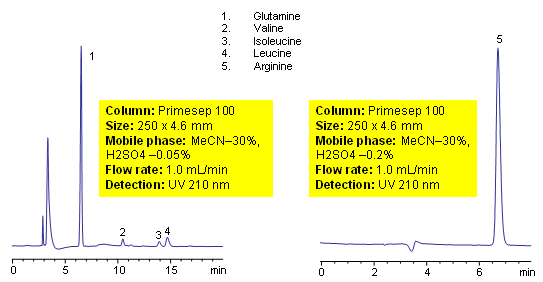
Glutamine, valine, isoleucine, and leucine are baseline resolved in a dietary supplement with a mobile phase of acetonitrile, water, and sulfuric acid with ultraviolet (UV) detection at 210 nm on a Primesep 100 column. Increasing the sulfuric acid concentration allows elution of arginine. Primesep 100 separates underivatized amino acids and amines by combining reversed-phase and ion-exchange mechanisms. The HPLC separation uses a mobile phase of water, acetonitrile (MeCN, ACN), and sulfuric acid with ultraviolet (UV) detection at 210 nm.
| Column | Primesep 100, 4.6×250 mm, 5 µm, 100A |
| Mobile Phase | MeCN/H2O – 30/70% |
| Buffer | H2SO4 |
| Flow Rate | 1.0 ml/min |
| Detection | UV, 210 nm |
| Class of Compounds |
Drug, Acid, Hydrophilic, Ionizable, Vitamin, Supplements, Amino acid |
| Analyzing Compounds | Arginine, Glutamine, L-Valine (Val/V), L-Isoleucine (Ile/I), L-Leucine (Leu/L) |
Application Column
Primesep 100
The Primesep family of mixed-mode columns offers a wide variety of stationary phases, boasting unprecedented selectivity in the separation of a broad array of chemical compounds across multiple applications. Corresponding Primesep guard columns, available with all stationary phases, do not require holders. SIELC provides a method development service available to all customers. Inquire about our specially-tailored custom LC-phases for specific separations.
Select optionsGlutamine
Isoleucine
Leucine
Valine

